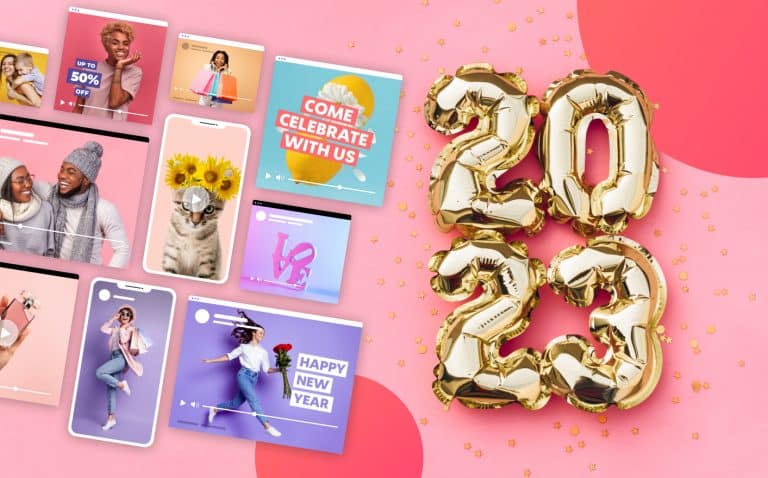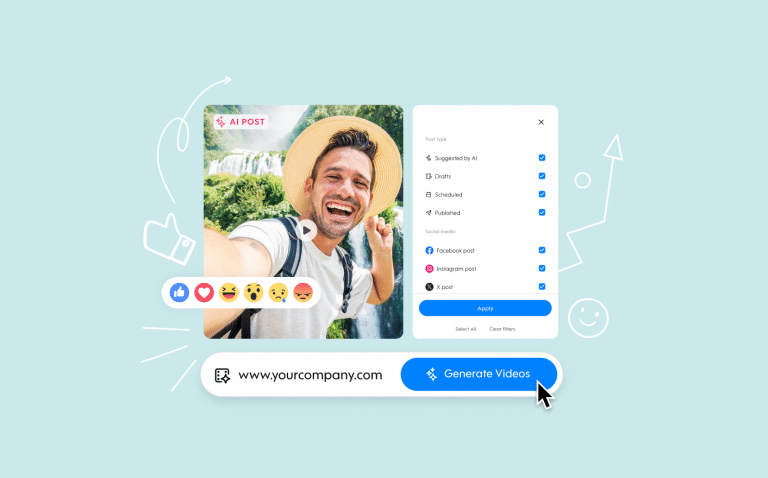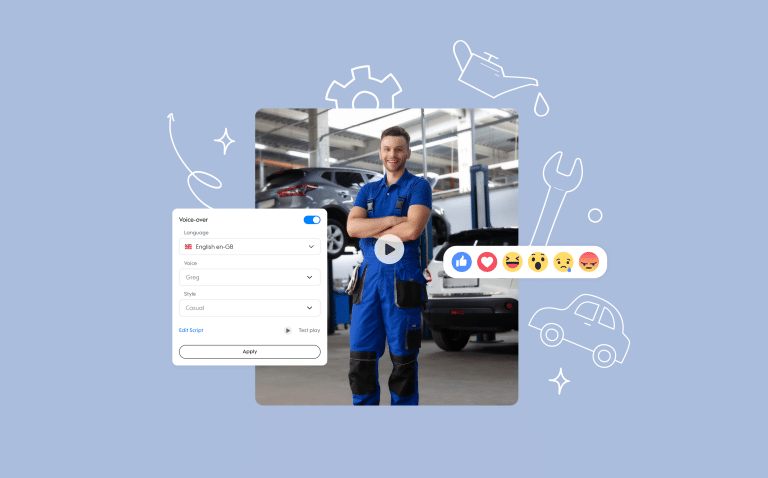
LinkedIn Advertising: The Complete Guide
When people think about advertising on social media, LinkedIn probably isn’t the first thing to cross their minds. But we’re here to change that.
LinkedIn has over 575 million members worldwide. It’s commonly used for making business connections, whether that’s networking colleagues or college grads searching for their first gig.
Here, we’ll cover everything you need to know about LinkedIn advertising, from the types of ads you should run to defining the success of your campaign.
Why advertise on LinkedIn?
LinkedIn isn’t just for job seekers anymore. Rather, it’s a networking powerhouse. Business professionals go to LinkedIn to exchange ideas, network within their industry, stay current on the hot topics and trends in their field, and yes; even to seek and share content.
What’s important to take away from this point is that people are actively seeking out and engaging with content from businesses that they find on LinkedIn. You can’t really say that about other social networks like Facebook and Instagram, where posts by businesses are deemed as disruptions to the content from friends and family that people really want to see.
LinkedIn is the best social channel for lead generation. It brings in more leads than any other social channel – 59% of marketers generate leads here compared to only 26% who generate more leads elsewhere.
It’s one thing to generate leads, it’s another to have those leads come from senior-level executives or decision makers. That’s exactly what LinkedIn does. Of its half a million users, 61 million are a senior-level employee and 40 million have the ability to make decisions for their company.
Not convinced yet? Check this out:
- 2 Professionals join LinkedIn every second. That means in the time it just took you to read that sentence and this one, about 10 or so potentially valuable connections just signed up. By the time you finish this entire article? Jeez, it depends on how quickly you read!
- 94% of B2B Marketers use LinkedIn to distribute their content. By comparison, only 77% use Facebook for the same purpose.
- Posts with video are 5x more likely to generate engagement than posts without.
- 80% of ALL B2B social media leads are generated on LinkedIn. More than Facebook, Twitter, and Instagram COMBINED.
LinkedIn is the place for B2B marketing. If you operate in this space, then LinkedIn is where you want to be.
You too can be successful with LinkedIn advertising, and when you want to create your first LinkedIn ad, you’ll have everything you need. So let’s go through the process step-by-step:
Choose a Goal
Choosing a goal is a crucial step in promoting content on LinkedIn, but you should have a goal in mind long before you actually start assigning dollars to an advertising campaign. Is it more leads? More website traffic? Increase your followers? Fully understanding your goal will result in more successful ads on LinkedIn.
When you open the LinkedIn campaign manager, your first step will be to choose an objective. Currently, you can choose between seven objectives:
- Brand awareness – Boosts impressions by displaying your ad to as many people as possible.
- Website visits – Drives traffic to a website outside of LinkedIn.
- Engagement – Reach people that are more likely to click, comment, or share your content.
- Video views – Displays a video ad to people who are most likely to watch it.
- Lead generation – Get quality leads for your business.
- Website conversions – Call users to complete a specific action on your website.
- Job applicants – Get more clicks on job-related content.
LinkedIn’s objective-based campaign creation experience is a new way for marketers to build advertising campaigns on the social network. Its purpose is to streamline the process, optimize your campaigns, introduce automated bidding, and improve reporting tied to your objectives.
Brand awareness, website conversions, and job applicants are still in the beta testing phase and may not be available to all LinkedIn advertisers right away. However, all objectives will be made available in the near future.
Remember, it’s ok to run multiple campaigns with different objectives. One campaign doesn’t have to accomplish all of your goals, so don’t force it.
The next step is targeting your audience.
Target your audience
This is another thing that you should decide before setting up a social media advertising campaign. Consider it just as important as making sure you have the right goal because if you’re not reaching the right people, you’re probably not achieving your goal anyway.
But who is your target audience? As a marketer, you’ve probably painted this picture a time or two. However, if you’ve never created any customer profiles, that’s a good place to start. Basically, customer profiling is the process of idealizing the people who buy your product or service, determining their age, location, gender, and various interests.
You can target your audience based on the following:
- Language
- Location
- Company Information – industry, company size, company name, connections, etc.
- Age
- Gender
- Education
- Job information – job function, years of experience, level of seniority, job title, etc.
- Interests – groups or industries
You can also exclude people. For example, if you’re targeting talent in only one region of the country, you can exclude the others. LinkedIn also has audience expansion, meaning LinkedIn will automatically increase the reach of your campaign when it applies to audiences similar to those that you’re targeting.
No other social network provides so much career oriented targeting. This is definitely LinkedIn’s advantage and you should use it accordingly.
Set a budget
There are a few different ways to set up your budget and schedule.
First, you’ll be able to choose between setting a daily budget, a total budget, or both. A daily budget means your campaign won’t spend past a predetermined dollar amount each day. A lifetime budget means the campaign won’t spend over a predetermined dollar amount over the extent of the campaign – a week, a month, etc.
Next, you set an ad schedule, which determines the start and end date for running the ad. This can have a big impact on your budget. Obviously, the longer you want your ad to run, the more money it requires. Keep this in mind when setting your budget.
There are also two different types of ways you can bid in order to achieve your goals:
- Automated bid: LinkedIn automatically determines how to spend the budget most efficiently while maximizing results.
- Maximum cost bid: You manually select how much you’re willing to pay per result – clicks (CPC), video views (CPV), or 1,000 impressions (CPM). Buyer beware. If your bid isn’t high enough, ad performance will suffer. After you set your bid, it’s important to keep a close eye on it and make an adjustment if necessary.
If you select a maximum cost per bid value, LinkedIn does provide a current estimated range for similar bids. Keep in mind, the higher your bid, the better your ad will perform.
But, don’t confuse a healthy budget with a healthy campaign. You have to know how to spend it wisely, which is why you must keep reading!
Ad types
LinkedIn offers marketers a variety of ad formats. Let’s find out which one would work best for your campaign.
Dynamic Ads
These ads are available in two formats:
Follower Ad
These ads increase brand awareness among your target audience by encouraging them to follow your company page. A Follower Ad includes your company profile photo positioned next to the viewer’s profile photo, creating an immediate visual connection.
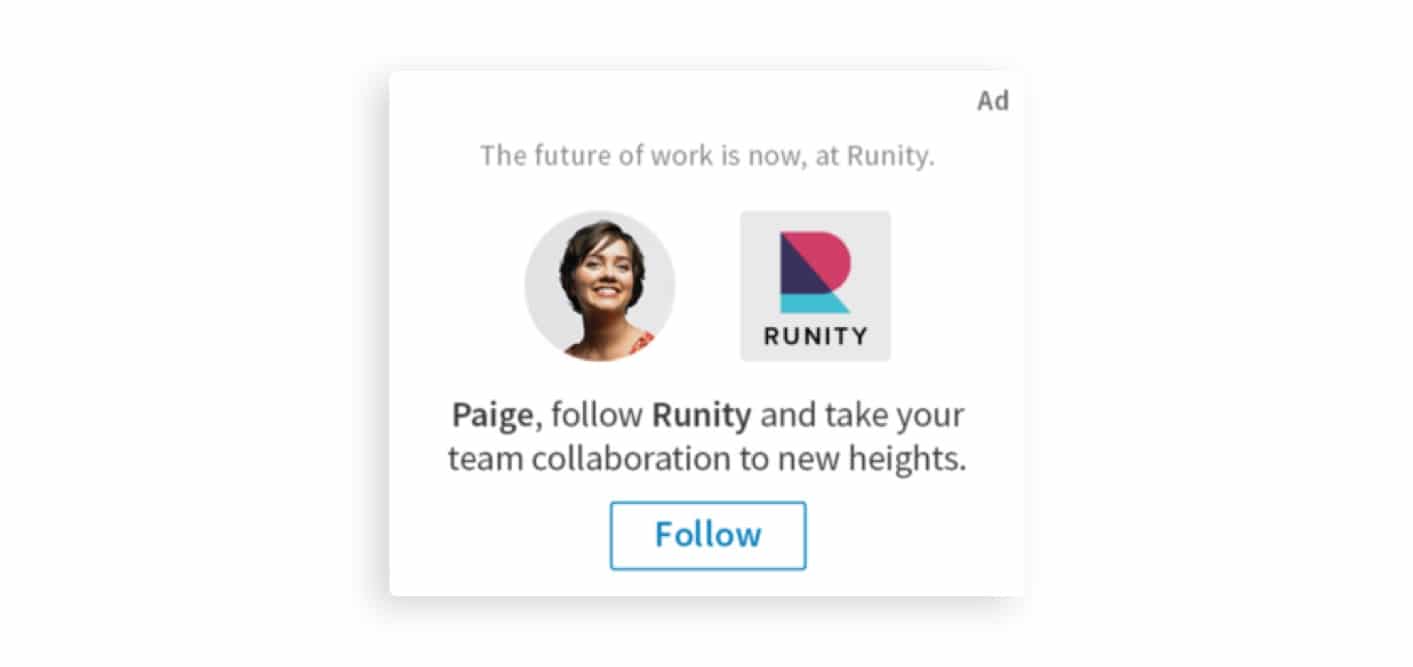
Best practices
Use this option if your company is new to LinkedIn and you’re trying to build a following of engaged users or you want to make an initial connection with potential recruits.
Pros and cons
LinkedIn does a lot of the heavy lifting for you. The ad is simple and to the point and creates an immediate connection between you and your target audience. They also provide suggested ad copy and preset CTAs.
Since this ad is so simple, it doesn’t reveal much information about your company and it leaves little room for creativity.
Spotlight Ad
A Spotlight Ad is similar to a Follower Ad, except its goal is to drive traffic to a selected website instead of a LinkedIn page. Use this to promote a product, service, or event. It also creates an immediate visual connection between your company and the person viewing the ad.

Best practices
Use a spotlight ad if your goal is to drive your target audience away from LinkedIn to an external source that will further information about your company, product, service, or event.
Pros and cons
A Spotlight Ad leads people to more information than a follower ad, so there’s more opportunity for them to become an engaged consumer. You can also add a customized background, allowing for more creativity and better brand awareness.
However, this is still a basic ad that doesn’t provide the opportunity to relay a lot of information about your business, product, or service. There’s not a lot of excitement to draw people in and opportunities are pretty limited.
Sponsored content
There are also two types of sponsored content: image and video ads.
Sponsored content with an image
Sponsored content is similar to regular updates in your newsfeed. The only difference is that the person doesn’t have to be following your company to see your content. You can reach your target audience with engaging content, like articles or blogs, that live on your website or landing page.
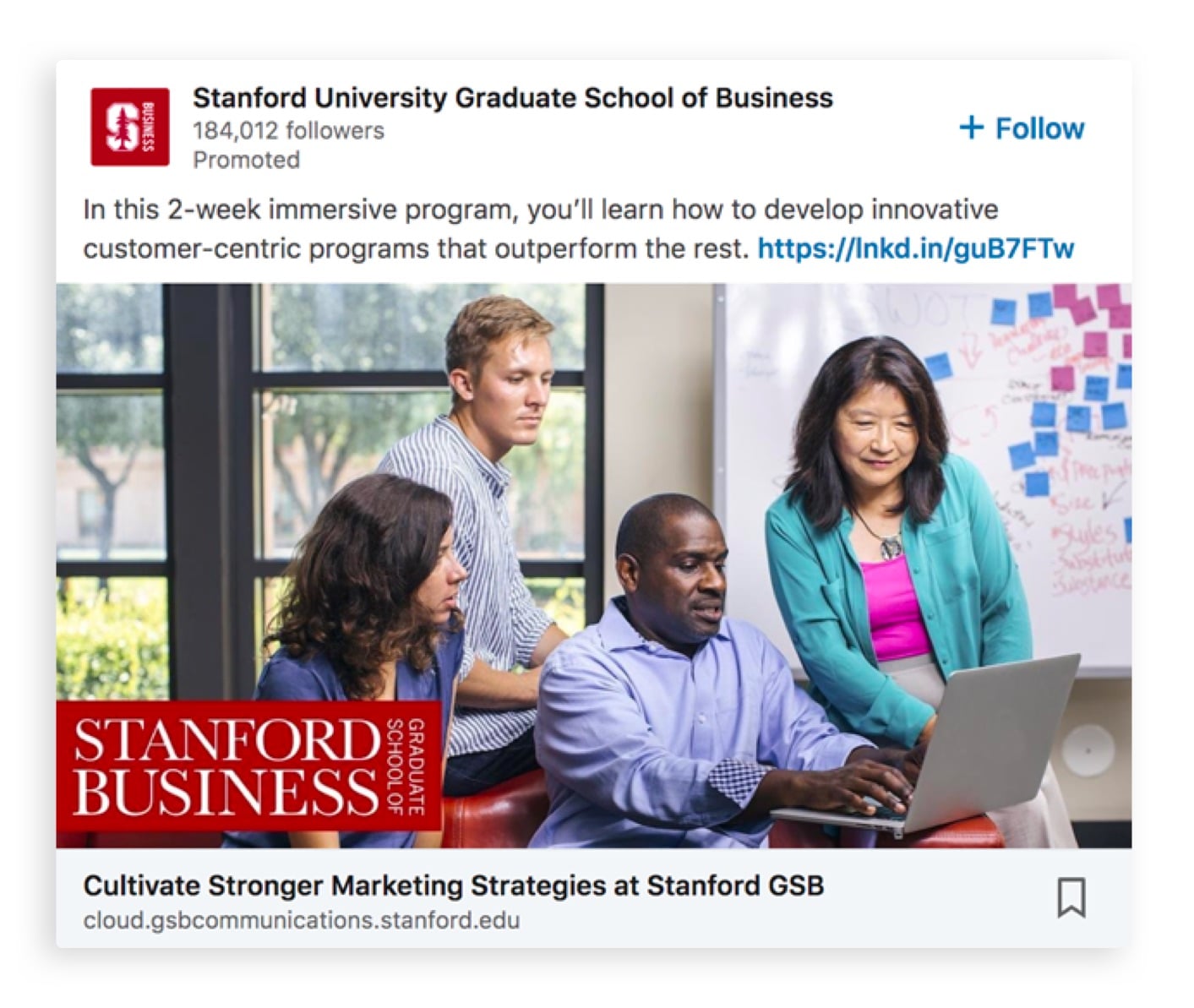
Best practices
Write copy and choose an image that will resonate with your target audience. It’s possible that this is their first interaction with your company and you want it to be memorable Include a strong call-to-action that entices people to learn more.
Pros and cons
Content ads are a great place to start for LinkedIn advertising beginners. Plus, if you’ve already got great content that people engage with, why recreate the wheel? People targeted by the ad can either choose to click through to your website or follow you on LinkedIn, either way, those are valuable engagements.
The downside of a content ad is that it can get lost in all of the noise. People are constantly sharing articles and news on LinkedIn and your ad might not stand out. Plus, the single image format is not as impactful as advertising with video. The trick is figuring out how to get people to stop scrolling and start clicking.
Sponsored content with video
Video is among the most engaging media across all social channels and LinkedIn is so exception. This is a great tool for building brand awareness, creating captivated audiences, driving clicks, and ultimately, driving leads.
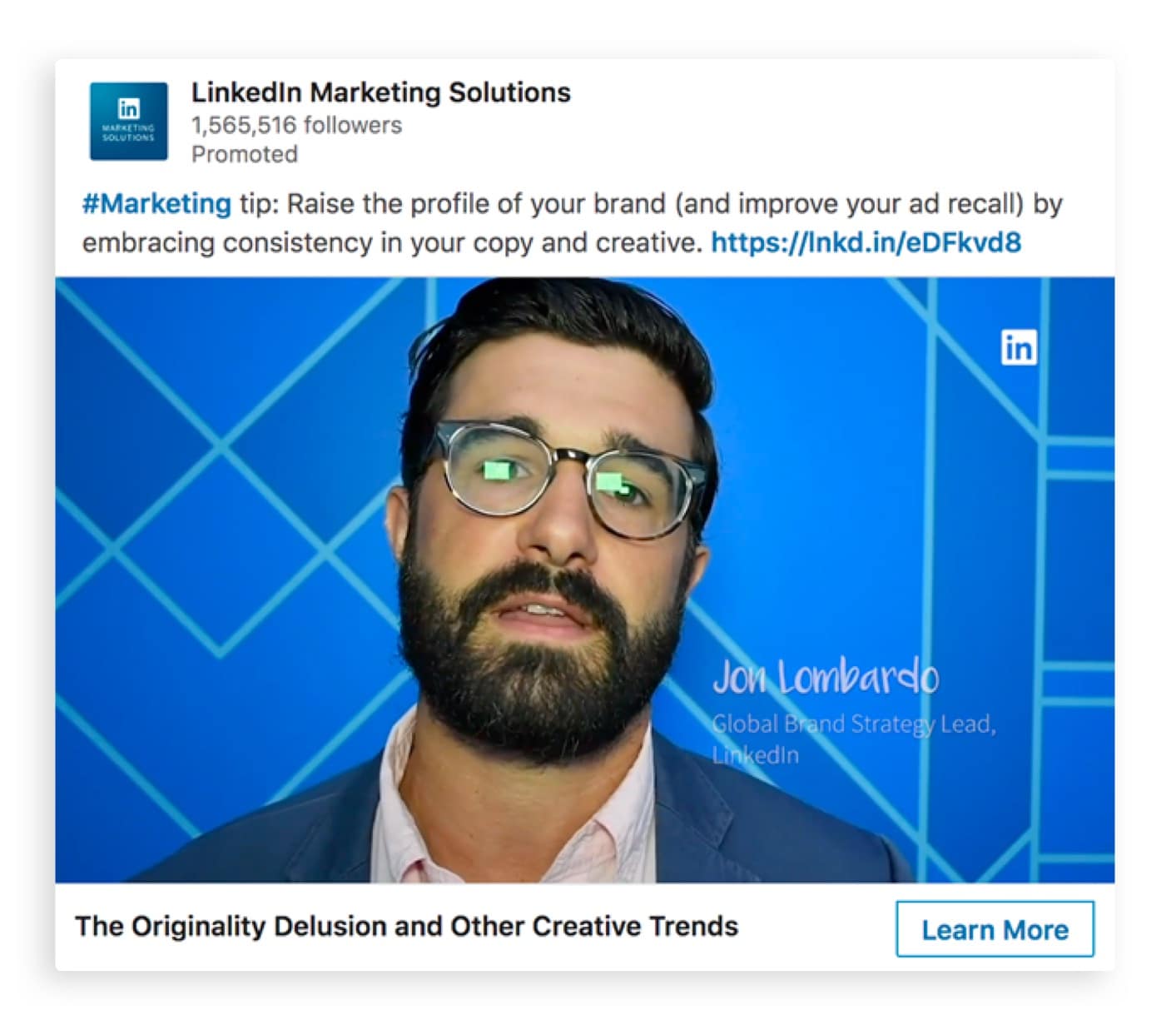 Best practices
Best practices
LinkedIn video ads need to be high-quality and professional in order to attract attention from your audience. Luckily, creating videos is easier than ever before (check out our video maker), even if you have little to no experience. Plus, professional videos don’t cost an arm and a leg, which means you can allocate more money to your ad spend.
Pros and cons
Video ads are one of the most effective and engaging ad types on LinkedIn – or any digital ad service, really. Professional quality video ads elevate your business from a branding standpoint and help you set yourself apart as an organized, professional business. After all, people retain 95% of a video’s message versus only 10% when they read it.
To some, creating a video can seem downright impossible. They’re time-consuming, costly, and quite difficult to edit without the right tools. However, tools like Promo reduce the time and costs considerably.
Sponsored InMail
LinkedIn might be the only place where sliding into someone’s DMs is a successful advertising strategy – but it works! Sponsored InMail is a highly personalized way to reach key members of your target audience. They receive a message right in their LinkedIn inbox.
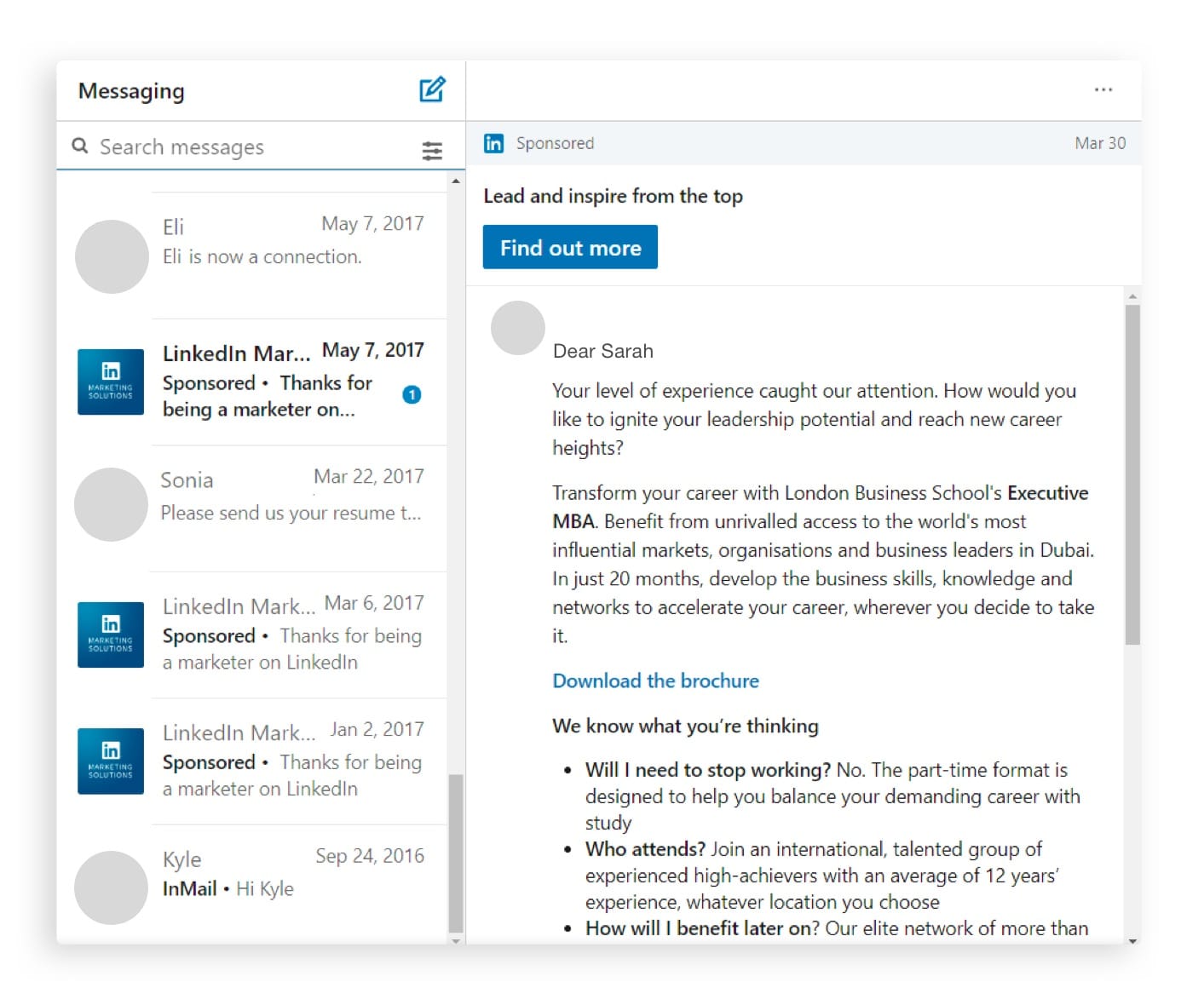
Best practices
With Sponsored InMail, you should personalize the message as much as possible. Try inviting someone to a relevant webinar or upcoming event, offer a special promotion on your product or service, or share valuable content that could be useful to the reader.
Pros and cons
Sponsored InMail is definitely a quality over quantity scenario. These ads can really drive lead generation and conversions when done right. This is a great way to open a conversation with decision makers and senior-level influencers.
If brand awareness if your goal, this ad type isn’t for you. These messages are sent to a highly-targeted audience and aren’t broadcast to the masses.
Text Ads
Text ads are basic, budget-friendly ads that appear in desktop newsfeeds without an accompanying image or video. But, they do drive traffic and generate leads, if that’s your goal. You can choose the ad’s destination, either on LinkedIn or somewhere else.
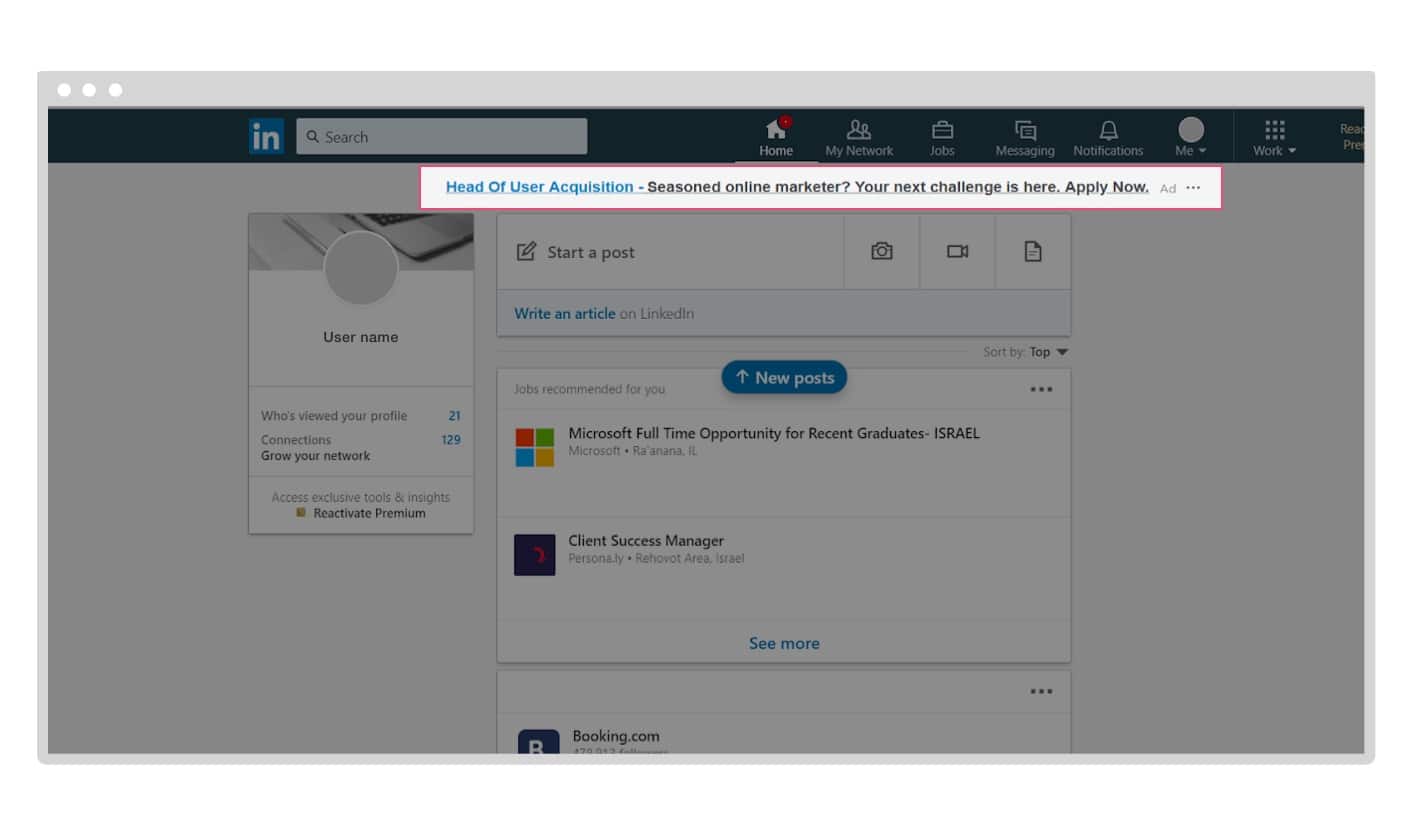
Best practices
Keep the copy catchy and concise. LinkedIn has a 25-character limit for the headline and 75-character limit for the description. These also make great retargeting ads to get back in front of people who have visited your website, recently followed your LinkedIn page, or have engaged with your content elsewhere.
Pros and cons
The best thing about text ads is that they’re quick to make and affordable to run. You only pay per click (PPC) or per impression, so you can set your desired budget for the number of clicks or impressions you hope to generate. Plus, you’ll have little to no creative costs.
With that, though, comes little to no creativity. Without an image or video to help your ad stand out, these ads often blend in with their surroundings and don’t make a big impact. Sometimes simplicity is a good thing, but not always.
LinkedIn has a lot to offer – just look at the different ad formats that can work for any business and any budget. We bet you have tons of ideas for building impactful ads. But there’s only one way to determine if work and that is knowing how to define success.
Defining and measuring success
Measuring the results of your advertising campaign is the only way to tell if it was successful. But first, you have to define what success means.
Remember earlier when we picked a goal for the campaign? Whether that was driving website traffic, increased brand awareness, or racking up video views, that will be your measuring stick for good or bad performance. What percent were you hoping traffic increased to your website? How many people did you want your video to reach? If you meet or exceed those numbers, you can deem your campaign a success.
Let’s consider a scenario. Say your video ad generates 10,000 views, 50 new followers on your LinkedIn page, and increases web traffic by 10%. Would you call that a success? For you, maybe so. But another company that had a goal of 15,000 video views, 100 new followers, and a 15% increase in web traffic would say no. See? Success can only be defined by your goals.
If your campaign didn’t perform as expected, don’t give up! Instead, figure out why and improve it. You can start by reviewing key elements of the campaign, like:
- The creative you used – image or video
- The ad type or objective you chose
- The budget
- The audience targeting
- The ad headlines or copy … and more!
When you narrow it down to the variable that you want to improve, how can you be sure that your second ad outperforms the first? We’ll give you one guess. (It’s testing.)
Testing your ads is a crucial step in measuring their success. And when you’re trying to improve performance, testing helps you make informed decisions about how to do just that.
In LinkedIn’s campaign manager tool, you can set up nearly identical ads with one minor difference – the variable that you’re testing. Actually, this practice is common across all social advertising channels. It’s called A/B testing, or split testing.
Think of A/B testing as an experiment. By running this experiment, you can determine how to continuously improve ads. Plus, you can test nearly anything about your ad, including the creative, copy, headline, targeting, and more.
To start an A/B test on LinkedIn, create a new campaign and apply all of the creative, targeting, and budget parameters. Then, set up a second campaign that is exactly the same except for one variable. According to LinkedIn, your test should run for at least two weeks.
You can run as many tests and change as many variables as you’d like. When you’re done, review the results and implement the winning changes. Ideally, you’re creating an ad that has proven to be successful.
Ready to get going?
Congrats! You made it to the end. Are you stoked to get started with your first LinkedIn advertising campaign? We know you were paying attention the whole time, but even if you weren’t, you can always refer back to this handy guide.
LinkedIn has something to offer for all businesses looking to grow their connections with social media advertising, especially B2B marketers or company’s looking to recruit new talent. And don’t forget, if at first, you don’t succeed, split test!
